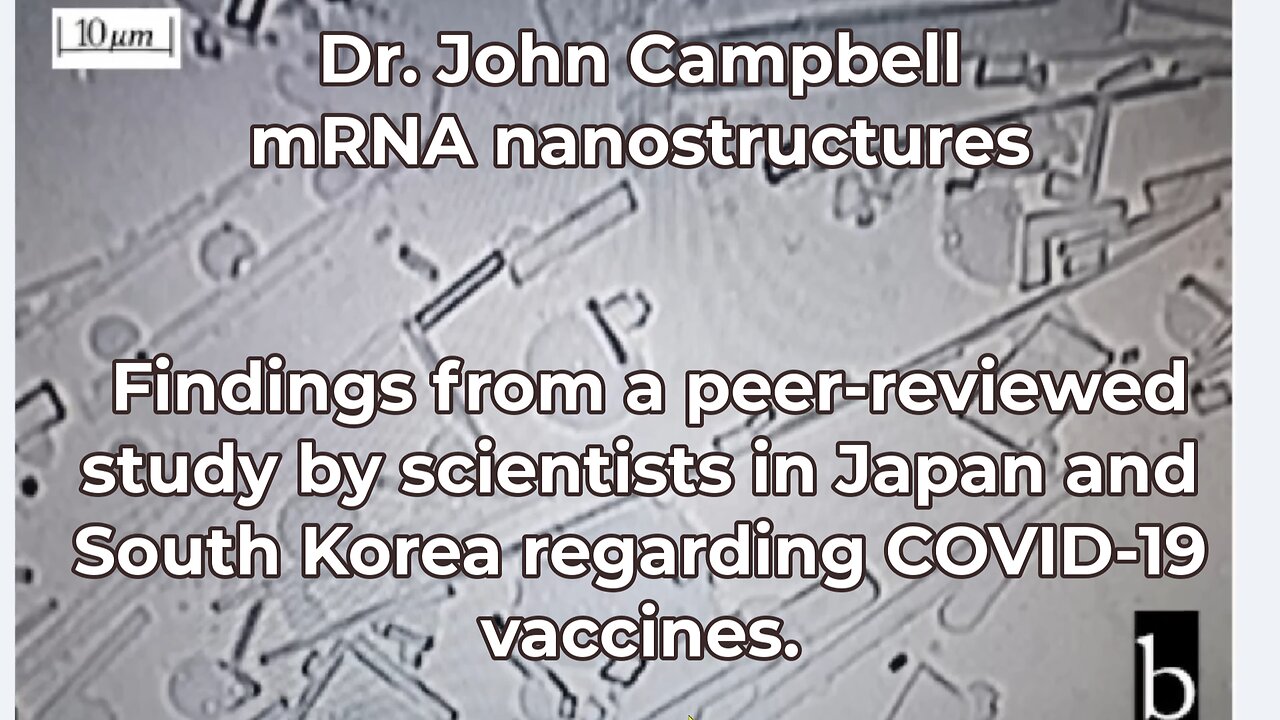Premium Only Content

mRNA nanostructures - peered reviewed science - by Dr. John Campbell
This video was removed from YouTube by Dr. John Campbell.
SUMMARY
(00:04) Introduction: The speaker discusses recent findings from a peer-reviewed study by scientists in Japan and South Korea regarding COVID-19 vaccines, mainly from Pfizer and Moderna, revealing the development of nanostructures in cultured samples mimicking human body conditions.
(00:51) Equipment and Observations: Researchers used stereoscopic microscopes to examine vaccine samples, discovering spontaneously forming two- and three-dimensional nanostructures at scales relevant to human cells.
(02:55) Need for Explanation: The presence of these nanostructures raises questions that require responses from vaccine manufacturers and regulatory agencies, stressing the importance of transparency in addressing these findings.
(06:31) Health Concerns: The study suggests correlations between observed injuries in vaccine recipients and the presence of nanostructures, with calls for further research into the mechanisms behind reported adverse reactions.
(09:59) Pollution and Composition: The study reports alarming numbers of these nanostructures (3-4 million per milliliter), which include various shapes and artifacts, indicating potential contamination beyond acceptable levels.
(11:11) Implications of Nanotechnology: The study suggests the presence of nanotechnology in the COVID-19 injectables, emphasizing the need for comprehensive studies to fully understand their implications for human health.
(14:03) Call for Public Engagement: The speaker encourages viewers to access the published study, emphasizing its availability for public scrutiny and the importance of open scientific discourse surrounding vaccine research.
TRANSCRIPT
(00:04) A warm welcome to this talk it's Friday the 6th of September now I've heard about this phenomena years ago of course but only just got some evidence to support it so we can only just report on it now. This is from peer-reviewed literature and it's scientists based in Japan and South Korea and what they've done is they've taken COVID vaccines mostly Pfizer and Moderna and cultured them incubated them to try and duplicate the conditions in the human body
(00:25) and the found nanostructures have developed. Now I don't expect you're going to watch this video or be allowed to watch this video but I'm going to do it anyway and if by some chance a few of you actually get to see it then that's brilliant. Now here's the equipment that was actually used here it's stereo microscopes now basically all this means is you're looking at it in the two eyes therefore you get stereoscopic vision and what happened was that initially
(00:51) they developed two-dimensional nanostructures and then some became three-dimensional as well and of course you can see that with a stereoscopic microscope. Let's go and look at some now that was the equipment that they were using and of course these days you know so much look down the microscope it all goes on a screen so you can take copies of it. Now these are from the publication these are then some of the nanostructures that were
(01:16) observed in as I've said before conditions that were designed to duplicate human cells in the human body that developed from the COVID vaccines the mRNA vaccines. Now the scale here we'll look I'll just show you a couple of pictures and we'll look at the scale so these are the sort of structures that we were finding I mean what the heck is that you know that that is a structure that spontaneously sort of put itself together a spontaneous
(01:45) assembly of this structure from the COVID vaccine cultures. Now the scale here 10 micrometres so that's so one micrometre would be the size of a sort of a bacterial cell seven micrometres would be the size of a red blood cell so you can see these are nanostructures but this is a very detailed looking structure that is spontaneously assembled itself here really quite really quite yeah well look at it you know that spontaneously assembled itself what
(02:23) the heck is it. Now of course as always we don't have I won't be giving full answers to these questions read the paper for yourself but this means the presence of these nanostructures needs to be explained by the manufacturers and by international authorizing agencies and national authorizing agencies around the world this is a peer-reviewed publication and I believe it gives questions to be answered even if it's only that this is a load of rubbish
(02:55) then that still needs to be it still needs to be answered let's look at a couple more pictures before we look at the text. So these spiral ones seem to come up again spontaneously just put themselves together spontaneous sort of the spiral there tell you what I don't like the idea of these spontaneously forming in the cells of my body if that is indeed the case we don't know that but if that's the case I don't like the idea at all not
(03:25) at all and 10 micrometres that's actually pretty big actually if that's the scale there 10 micrometres so this this whole thing is actually is actually quite large relatively speaking what is that spontaneously formed structure well that one anyway lots more examples in the paper do look at it for yourself and check it out that the paper is there and the pictures are all there now as I say I don't think many people are gonna be able to watch
(04:00) this video because I'm not optimistic about getting a wide distribution shall we say but never mind we're gonna do it anyway so real-time self-assembly self-assembly these things are bolting themselves together as it were of stereoscopic stereomicroscopically visible so you can see them through the stereomicroscope specimens of mRNA products mainly from Pfizer and Moderna a comprehensive longitudinal study so construction in constructions in
(04:31) incubated specimens of mRNA products is what these workers did and our observations suggest the presence of some kind of nanotechnology in the covered injectables now I'm I know what I'm I know this is sounds pretty interesting material and I'm only I'm being very very very careful not to go outside of what the article is saying the peer-reviewed article is saying and of course I'll be giving you full references and everything for that
(05:02) so I'm being very careful in this in this video not to go outside what it's saying observable observable real-time injuries at cellular level in the recipients of the safe and effective COVID-19 injectables are documented here for the first time hence the fact that we're doing I think this paper just came out a few days ago last week maybe with a presentation of a comprehensive description and analysis of
(05:27) observed phenomena that need to be explained the global administration of these often mandated products from late 2020 triggered a plethora of independent research studies why weren't they nationally sponsored and industry sponsored research studies why is it down to independent scientists and I have talked to several other independent scientists who've come up with similar findings to this but I can't talk about those because it's not published in the
(05:54) peer-reviewed literature we're going to stick to what is in the peer-reviewed literature of modified RNA injectable gene therapies so of course they're injecting genetic material instructing the body to make foreign proteins they are not injecting the protein directly most noticeably those manufactured by Pfizer and Moderna in this paper analysis report analysis reported here consists of precise laboratory bench science aiming to understand why serious
(06:31) debilitating prolonged injuries and many other side of this particular adverse reaction occurred increasingly without any measurable protective effect the contents of the COVID-19 injectables were examined under a stereoscopic microscope up to 400 times magnification carefully preserved specimens were cultured in a range of distinct media to observe immediate and long-term cause and effect relationships between the injectables and
(07:01) living cells under carefully controlled conditions in other words I'm not saying these scientists succeeded in doing that but what they were trying to do is duplicate living conditions in the laboratory bench where they could look at it under these microscopes they were attempting to duplicate the physiological conditions of the human body the degree to which they did that I'm not really able to adjudicate on but they did their best
(07:26) to do that and again this needs to be duplicated around the world and it needs to be explained because I mean I mean look at it I mean what is that what are these things I mean it's just yeah an explanation is clearly required here I would have thought I would have thought let me know what you think anyway let's carry on carefully controlled conditions from such research reasonable inferences can be drawn about observed injuries so they're saying that
(07:58) it's reasonable that the researchers here are saying it's reasonable to make inferences from what they're seeing in the laboratory work to what will be happening in the body because they're trying to duplicate the conditions in the body of course the study should be done in the body as well this should be a great trigger for future research done by authorized institutions around the world and regulatory bodies around the world this should be done to explain this don't hold
(08:25) your breath right from such research reasonable inferences can be drawn about observed injuries worldwide that have occurred since the injectables were pressed upon billions of individuals so they're saying that this basically what they're saying is I think this is a pathophysiological mechanism that could explain the adverse reactions or some of the adverse reactions that we are tragically seeing and of course we've interviewed quite a few people now on this channel
(08:52) who've suffered from this as well in addition to cellular toxicity as if that wasn't bad enough our findings reveal numerous on the order of three to four so that's between that's that's ten to the six that's three to four million of these artifacts per mil of the injectable heck that's four that's four one two three one two three up to up to four million between three and four million dear me visible artifacts self-assembling entities self-assembling entities
(09:29) ranging from about one micrometer to about a hundred micrometers hundred microns or greater of many different shapes as we said one one micrometer is about the size of a bacterial cell if you've got good young eyes you could probably just about see an object of a hundred micrometers it's a tenth of a millimeter isn't it with the naked eye at a push I probably couldn't at my age but maybe with my glasses anyway the researchers go on they were animated worm-like
(09:59) entities disc chains spirals tubes right angled structures right angled structures containing other artifact artifactual entities within them artifacts within artifacts all these are exceedingly beyond any expected and acceptable level of contamination of the COVID-19 injectables I would have thought three to four million per mil is way off the scale indeed an incubation studies revealed the progressive self-assembly self-assembly of many
(10:35) artifactual structures what the heck are they as time progressed during incubation simple one and two-dimensional structures over two or three weeks became more complex in shape and size developing into stereoscopically visible entities in three dimensions these became three-dimensional structures in their incubated cultures designed to replicate the conditions inside the human body they resembled carbon nanotube filaments ribbons tapes some appearing as transparent thin flat
(11:11) membranes others as three-dimensional spiral beaded chains some of these seem to appear then disappear over time our observations suggest the presence of some kind of nanotechnology in the COVID-19 injectables now this is directly from peer-reviewed literature I don't expect you'll see it I suspect strongly that I am currently talking to myself in a back room in Carlisle somewhere if some of you do get to see it then we consider that a bonus you can
(11:48) think about it now I'll just give you some of the references here for this so this is the this is the journal here International Journal of Vaccine Theory Practice and Research the International Journal of Theory Practice and Research is a peer-reviewed scholarly open access journal concerning the development distribution and monitoring of vaccines and their components all content is freely available without charge to the user or his her institution
(12:18) which of course is excellent users may read download copy distribute print search or link the full text of articles or use them for any other lawful purpose permission is not required from the publisher nor from the author but we do give them full credit of course isn't this refreshing this is our work we're reporting on it and it's it's free it's in the public domain it is the antithesis of the control of the control agenda that so often we've seen with people not
(12:54) wanting to release papers for decades after the research has been done very refreshing so that is about the journal there the actual article itself is have we got the article itself um what do I do oh there we go that's the that's the journal there uh that's the full journal and again you can download the full journal quite excellent so that's the paper that's the journal I've downloaded in pdf of course and that's the
(13:28) attribution non-commercial non-directive deed I don't quite fully understand that but it just it's great that it's basically uh share you are free to share and uh it's it's just um it's just and of course we give full credit to the authors which I will do now um these are the authors here a physician uh dr young my lee uh republic of korea and uh professor uh browdy okinawa christian university japan of course the links as always are there to check them out for yourself so what
(14:03) we've done is report on a peer-reviewed paper it's in the scientific literature as we've completely demonstrated in this video I'm just sorry that um I suspect that not many of you'll get to watch this video but there we go um yeah isn't that transparency refreshing and really refreshing to see that this is our work look at it share it agree with it disagree with it do further work to prove it do further work to
(14:33) say it's a load of rubbish but it's there open for public peer analysis brilliant the antithesis to so much of the more commercial research of the past few years and decades but for now look there for yourself let me know what you think if any of you actually get to see it so bye hope I'm not talking to myself but thank you for watching if somehow you have
-
 LIVE
LIVE
The Bubba Army
20 hours agoTrump Demolishes The WHITE HOUSE! - Bubba the Love Sponge® Show | 10/21/25
5,363 watching -
 8:11
8:11
Tactical Advisor
11 hours agoBREAKING NEWS! Glock Discontinues All Models?! NEW Glock V
7702 -
 UPCOMING
UPCOMING
RiftTV
7 hours agoASTROTURFED! The Fake Anti-Trump Movement Exposed | DC Dive | Guest: Kaelan Deese
2.16K -
 UPCOMING
UPCOMING
BEK TV
21 hours agoTrent Loos in the Morning - 10/21/2025
121 -
 LIVE
LIVE
Side Scrollers Podcast
1 day ago🔴SIDE SCROLLERS FUND-A-THON🔴DAY 1🔴100% REVENUE HELPS CHANGE CULTURE!
1,298 watching -
 6:00
6:00
China Uncensored
1 day agoWar With China Is Coming
14.5K52 -
 40:45
40:45
Jasmin Laine
15 hours ago“If You Have a Problem, I Don’t Care”—Jamil Jivani OBLITERATES the Woke Regime
3.13K11 -
 1:04:51
1:04:51
MTNTOUGH Podcast w/ Dustin Diefenderfer
20 hours agoJustin Wren: From MMA to Congo, The Wild Story Behind His Vanishing Act | MTNPOD #138
3.71K1 -
 7:47
7:47
The Shannon Joy Show
13 hours agoRepublicans need to WAKE UP... feat. Maria Zeee
3.41K5 -
 4:28
4:28
DropItLikeItsScott
13 hours ago $1.48 earnedI Tried To Break The STOPBOX Here's What Happened!
3.32K1